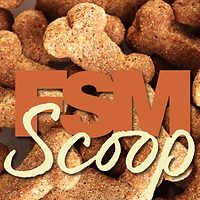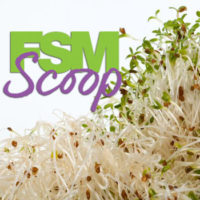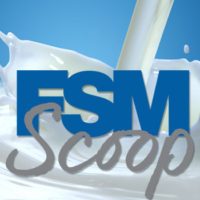FSM Scoop: Food Fraud

Food fraud is far deeper than a cut-and-dry food safety incident, an instance that is unforeseen and unintentional. Fraud, on the other hand, is committed on purpose. Every business exists for one reason--to make money. Unfortunately, some food companies--or individuals employed by those companies--are willing to do whatever it takes to increase profits by cutting corners, which puts food safety and quality at risk.
Food fraud is the act of purposely altering, misrepresenting, mislabeling, substituting or tampering with any food product at any point along the farm-to-table food chain. Fraud can apply to an overall food product, a single ingredient, or a food’s packaging.
Why Does Food Fraud Occur?
Cases of food fraud don’t creep up out of the blue. Food companies increasingly battling with competitors that offer cheaper products. Crops unexpectedly yield less food, or poor quality food. These circumstances--referred to as “triggers”--can force food industry workers to think outside the box in a negative way, opening up the door to fraud and adulteration.[1]
We are all aware that the global food supply chain is a complicated entity. Even for the simplest food product--a cookie, perhaps--ingredients are required from suppliers around the world and are eventually blended together, then packaged and distributed to consumers everywhere. This intricate process is performed day in and day out worldwide. So it makes sense that fraud can easily and frequently present itself at any point along the food supply chain, whether it be on the farm, in the food processing plant or even in how the product is marketed or labeled.
What Does Food Fraud Look Like?
There are many instances of food fraud that occur both in the U.S. and across the globe. Peanuts are labeled as pine nuts. Horse meat is passed off as beef. Olive oil, coffee, tea and fruit juices are diluted with cheap fillers. Honey is thinned out with corn syrup. Italian olives are painted with a sulphate solution to make them appear brighter. Shrimp are injected with antibiotics that are not safe for human consumption. Food ingredients that expired years ago are placed on store shelves for consumers to purchase. And most of these fraudulent foods are bought and consumed without the consumer ever knowing the true identity of what they’ve eaten.[2, 3, 4, 5]
Many past cases of food fraud had one common denominator--melamine. The toxic industrial chemical--approved for use in fertilizers, countertops, dishware and plastic and paper products—has become the poster child for adulterants. It’s been found in pet food and in baby formula manufactured in China. Melamine is not U.S. Food and Drug Administration (FDA)-approved for direct addition to human food or animal feed marketed in the U.S.[6]
But that doesn’t stop food fraudsters.
In the case of contaminated baby formula, it started with raw milk that was diluted with water in an effort to increase its volume. This practice lowered the milk’s protein concentration, however. When that diluted milk was then used to produce baby formula, food fraudsters needed to increase protein levels. This is where melamine came in. Melamine is very rich in nitrogen, which makes it an attractive food additive. Simply put, melamine was added during the production process in an effort to raise nitrogen levels, which ultimately gave the appearance of higher protein levels. The problem was that mediocre sources of melamine metabolize into harmful byproducts, ultimately creating a health risk to both humans and animals.
One of the main reasons that food fraud doesn’t get as much attention as it deserves is because the effects on the human body usually go unnoticed, or the connection between illness and fraudulent food consumption is not clear. Because the health implications are rather subtle, food fraud remains on the food safety back burner.
According to the World Health Organization, the effect of melamine consumption on the human body has yet to be studied. However, the effects have been analyzed in the form of animal studies, which may predict similar effects on the human body. Animal tests show that consumption of melamine can lead to bladder stones and kidney stones. Stones can block the production of urine, triggering kidney failure. It can ultimately be fatal. In fact, evidence of this effect on humans was demonstrated when 300,000 infants experienced kidney damage and 13 died as the result of consuming melamine-laced infant formula.[7, 8]
According to Jeffrey Moore of U.S. Pharmacopeia, “The melamine example demonstrates that the fraudsters’ ethics and, in this case, lack of knowledge—they didn’t understand the toxicity of melamine and related compounds—defined food safety throughout the supply chain.”
How Does Food Fraud Fly Under the Radar?
Before these devastating cases occurred, food companies did not routinely test for melamine. In fact, historically, food companies have not tested for hundreds if not thousands of possible adulterants. In the cases of tainted baby formula and pet food, not even the most reasonable person would think to test for melamine--a chemical used to make countertops. Why would melamine ever be present in a food product?
But it was.
Food fraud can only be detected for substances, chemicals and additives that are tested for. So what happens to all the contaminants that are not tested? They unfortunately go unnoticed.
According to Defining the Public Health Threat of Food Fraud, “Current intervention systems are not designed to look for a near infinite number of potential contaminants.”[9]
Some might argue that it’s understandable that all food ingredients cannot possibly be tested for every single contaminant. But could it be that the real reason food fraud goes undetected is all about money? The gas chromatography-mass spectrometry equipment and reagents required to detect food fraud are extremely expensive. Could companies be skeptical to spend money on the off chance that no product contamination is detected?[10]
Somewhere along the food chain, someone knows that fraud is taking place. And they also know just how difficult it is for the crime to be exposed. So contaminated product is sold to companies that may not perform the specific testing required to detect it. What’s more, at least one source claims that some companies will agree to knowingly buy contaminated product and keep quiet in return for a lower purchase price.[11]
There’s been plenty of finger pointing going around. Food companies are blamed for not investing in testing. The FDA is blamed for being underfunded and understaffed, not having enough manpower to police food manufacturing processes. As a result, criminals have found ways to capitalize on these weaknesses.
Consumer Risks
There’s a bit of irony in all of this. Consumer demand for food that is fresh, local and sustainable is at an all-time high. People are paying top dollar for food products labeled as organic, all-natural and free of genetically modified ingredients. The truth, though, is that every day consumers are buying foods--high-priced foods--many that are simply not what they believe them to be.
Food fraud does present some very real business impacts--loss of consumer trust, declining sales and massive public relations crises. But none of that compares to the impacts that food fraud can have--and has had--on human lives. Yes, food fraud is potentially life-threatening, as was the case with tainted baby formula from China and melamine-tainted pet food.
Still, according to the Global Food Safety Initiative, “most cases of food fraud are not harmful.” It’s true that these cases don’t typically lead to widespread outbreaks or product recalls. But that doesn’t negate the fact that fraud is potentially dangerous and poses a very real public health concern.[12]
Let’s take honey, for example--reportedly the most commonly adulterated food product. Honey sourced in China has been filled with chemicals that are actually illegal to use in American food production. One example is chloramphenicol, a potentially fatal chemical that has caused the European Union to completely ban honey from China. (Women’s Health)
For consumers who cook with olive oil, the food safety threat is tremendous. That’s because olive oil is often diluted with other oils, specifically peanut oil. So if a consumer has a peanut allergy and is cooking with contaminated olive oil that contains peanut oil, it becomes a very serious life-threatening situation. By the time food adulteration is uncovered, the health effects--in the form of a severe allergic reaction or organ failure--have already taken place.
Can Food Fraud be Stopped?
Some food fraud experts say that the best way to prevent continued economic food adulteration is for food industry employees to speak up when they see wrongdoing.[13]
On the consumer front, shoppers are urged to be vigilant, however, this is an impossible feat for even the most careful consumer. While highly priced foods may be associated with higher quality, price alone can never determine whether or not a food product has been illegally altered.
That leaves just one universal solution to combat food fraud: testing.
- http://www.bigissue.com/features/6283/food-fraud-what-is-really-on-the-menu.
- http://barfblog.com/2016/05/food-fraud-police-and-interpol-crackdown-on-toxic-food/.
- http://www.foodandwine.com/blogs/wine-fraud-alert-worlds-most-expensive-burgundy-pulled-auction.
- http://barfblog.com/2016/05/food-fraud-22-tons-of-expired-food-ingredients-250-kg-of-seafood-uncovered-in-taiwan/.
- http://time.com/money/4326354/fake-olive-oil-food-fraud/.
- http://www.food-safety.com/magazine-archive1/junejuly-2015/modern-tools-for-food-ingredient-safety/.
- http://www.who.int/csr/media/faq/QAmelamine/en/.
- http://www.food-safety.com/magazine-archive1/junejuly-2014/whistleblowing-food-safety-and-fraud/.
- http://onlinelibrary.wiley.com/doi/10.1111/j.1750-3841.2011.02417.x/epdf.
- http://www.who.int/csr/media/faq/QAmelamine/en/.
- http://www.womenshealthmag.com/food/food-safety.
- http://ec.europa.eu/chafea/documents/food/food-fraud-2324102014-rey_en.pdf.
- http://www.food-safety.com/magazine-archive1/junejuly-2014/whistleblowing-food-safety-and-fraud/.
Looking for a reprint of this article?
From high-res PDFs to custom plaques, order your copy today!





